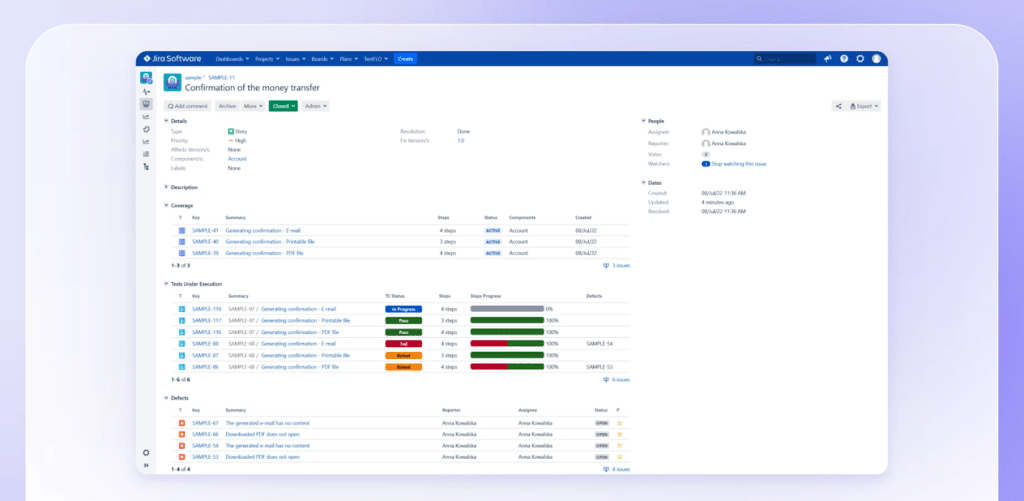Choosing Jira tool for testing: Overview of 13 tools + best practices

Updated: February 9, 2024
Table of contents
- Jira in test management
- Overview of 13 Jira tools for testing
- AIO Tests: QA Testing and Test Management in Jira
- ALM – Test Management for Jira Cloud
- Infodation Test Management system
- PractiTest Test Management for Jira
- QAlity Plus – Test Management for Jira
- TestRail Test Management Integration for Jira
- TestRay – Requirements and Test Management for Jira (SynapseRT)
- Tricentis Test Management for Jira
- Xray Test Management for Jira
- Zephyr Squad – Test Management for Jira
- Requirements & Test Management for Jira
- TestFLO – Test Management for Jira
- Best practices for choosing Jira tool for testing
- Comparison of Jira and dedicated test management tools
You’ve probably heard about Jira as a project management software. However, did you know it also serves as a functional testing tool?
In this article, we will explore the essential pros and cons of using Jira as a test management tool. We will also explain how to choose a Jira tool for testing, along with examples of these tools.
Jira in test management
When you want to use Jira for testing, there are two main options:
- Utilize Jira to monitor testing tasks
- Employ a test management add-on for Jira
The first approach involves using Jira’s native issue-tracking feature to manage testing activities. You may create tasks for testing that are related to the development issues, or, you can use customized issue types.
Jira as a testing tool
Jira isn’t dedicated solely to testing. Instead, it’s an integrated platform that manages projects, users, and workflows cohesively.
People like using it because of its adaptability and customizable fields. Instead of juggling separate tools for requirements, testing, and managing project schedules, teams can consolidate all data in one place. And that’s a huge advantage.
But, if a team has a lot of complicated testing to do, there could be some problems with using only Jira for test management.
Advantages of using Jira for test management
Cost-effectiveness
Jira is a money-saver because it lets you do everything in one place. Instead of using different apps and tools, just set up Jira and start using it quickly. It’s a budget-friendly choice compared to other tools made just for test management.
Standalone testing apps have a major issue. They often require teams to prepare data, manage members, and organize workflows externally. But, by shifting the process to Jira, you can meet all your needs within minutes.
It’s a workflow-powered tool
Test management relies on well-designed and flexible workflows. Additionally, by implementing testing processes in Jira, you offer a familiar, all-in-one platform. In this context, requirements, test cases, defects, Epics, and user stories seamlessly link. You can customize workflows. This makes collaboration between analysts, testers, and developers much easier.
It’s an environment most teams know
Jira offers a transparent, user-friendly interface. The apps are intuitive and easy to learn. If your team already uses Jira for project management and development, it’s smart to use it also for test management. By doing so, you can save both time and money, as there’s no need for extra training.
It promotes greater integration of processes
In Jira, everything is well-connected – issues, requirements, and test cases. It makes managing projects, reporting issues, and getting feedback smooth. Your team will surely appreciate continuity and transparency. They can execute test plans, manage code repositories, and get more tasks done in a shorter time.
Limitations of using Jira for test management
Complex test case organization and planning
Jira’s native issue-tracking functionality is not designed for test case management. Organizing and planning tests can be complex. To do that without additional plugins, there are two options:
- Work tests into your regular Jira workflow. Use the issue description fields and subtasks in Jira to log test information. It might get messy and not show progress well.
- Create custom Jira issue types for better control of tracking. Yet, it can make Jira boards cluttered and difficult to use.
Difficulty in reusing test cases and tracking results
If you want to use test case management tool again in Jira, it’s not so easy. While you can copy them from one place to another, it gets slow when dealing with a bunch of issues for a full test.
Also, these copied issues don’t keep track of how well the tests did over time. It makes it hard to spot trends and make testing more efficient.
No test automation support
If you’re using tools like Cucumber for BDD or frameworks like JUnit for automated tests, it’s not easy to blend these with the rest of the manual testing you’re tracking in Jira. It can lead to silos within the QA team and make it difficult to get a holistic view of the testing process.
Lack of reporting on test coverage or traceability
Jira lacks built-in reports for showing how many tests cover certain requirements. It also lacks built-in reports for traceability. You might need other tools or manual work for these reports.
Overall, Jira can be a useful tool for basic test management, but it is not ideal for complex testing needs. If you need to track many cases or use automation, you might need a dedicated test management tool.
Overview of 13 Jira tools for testing
AIO Tests: QA Testing and Test Management in Jira

| Atlassian Marketplace rating | 4/4 (72 reviews across hosting types) |
| Pricing | Free up to 10 users First 100 users USD 1.50 / monthly per user |
AIO Tests offers a range of features suitable for diverse testing needs. From testing using cases, sets, and cycles to executions.
Key features:
- End-to-end test management
- AI-assisted test creation
- Customizable fields, preferences, and permissions
- BDD support, and seamless integration with various testing frameworks and CI/CD pipelines
- Bulk operations and offline execution
- Cross-project capabilities
ALM – Test Management for Jira Cloud
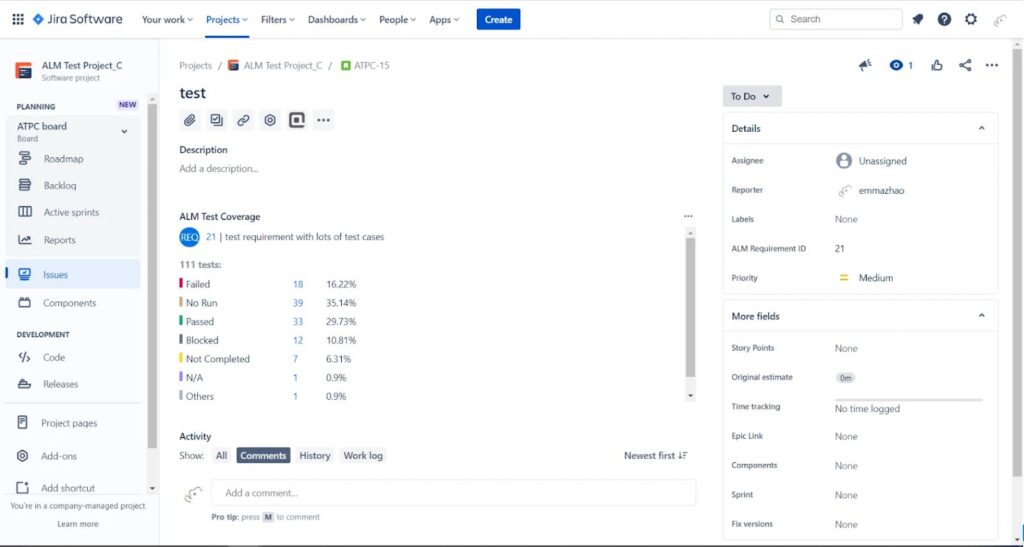
| Atlassian Marketplace rating | 3.4/4 (7 reviews across hosting types) |
| Pricing | Free app |
ALM – Test Management for Jira increases visibility into quality processes managed in ALM/Quality Center. It integrates vital information into Jira’s native epics, stories, issues, or custom types.
Key features:
- Overview of the number of tests linked to the entity
- Test status of latest test runs
- Overview of related test plans in ALM Client
Infodation Test Management system
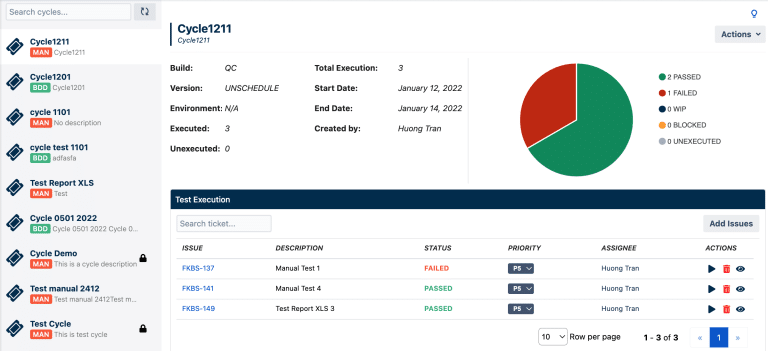
| Atlassian Marketplace rating | 3.5/4 (85 reviews across hosting types) |
| Pricing | Free app |
Infodation is a test management application designed specifically for Jira Cloud. It simplifies solutions for Test Design and Test Automation processes.
Key features:
- Create BDD test cases using Gherkin
- Translate manual test cases into automation
- Schedule automated executions for CI/CD
- Organized view of all tests within a project
- Progress tracking and sharing
PractiTest Test Management for Jira

| Atlassian Marketplace rating | 3.5/4 (14 reviews across hosting types) |
| Pricing | Free app |
PractiTest stands as a comprehensive End-to-End Test Management solution. It complements Jira with test management for automated and manual testing processes.
Key features:
- Report, track, and sync bugs, user stories, data, status, and fields
- Integrates with any testing approach or tool
- Overview of dashboards & reports
- Bug reporting capabilities with reproduction steps
Best for linking requirements & user stories to tests
QAlity Plus – Test Management for Jira

| Atlassian Marketplace rating | 3.6/4 (14 reviews across hosting types) |
| Pricing | Free up to 10 usersFirst 100 users USD 1.50 / monthly per user |
QAlity Plus offers a blend of test creation and bug reporting. It lets you plan and execute tests, integrating directly with Jira issues.
Key features:
- Create and manage tests and link them to existing Jira issues
- Identify and report bugs while executing tests
- Plan, execute, and track test cycles with marked failed steps
- Use the Traceability Report for insights into system coverage
TestRail Test Management Integration for Jira
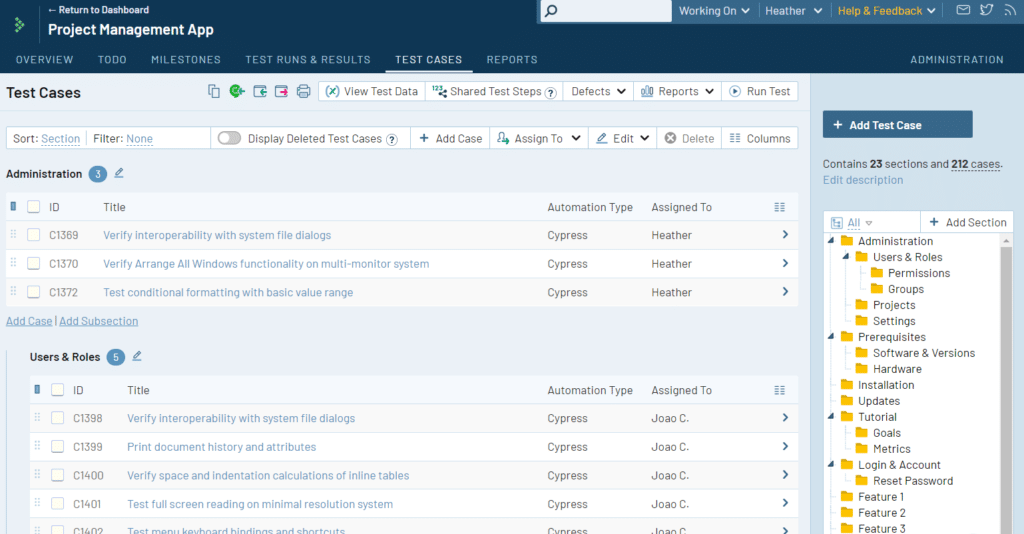
| Atlassian Marketplace rating | 3.1/4 (103 reviews across hosting types) |
| Pricing | Free app Cost: TestRail software subscriptions |
TestRail increases visibility and control between QA and Development teams. It acts as a single source of truth for quality. It provides full control over their test management processes.
Key features:
- Manage tests using folders and customizable fields
- Link tests to Jira issues
- Link test artifacts to requirements and defects
- QA reports and charts
- Permissions control
TestRay – Requirements and Test Management for Jira (SynapseRT)

| Atlassian Marketplace rating | 3.6/4 (61 reviews across hosting types) |
| Pricing | Free up to 10 users First 100 users USD 2.70 / monthly per user |
TestRay focuses on end-to-end test management in Agile and DevOps team environments. It offers a robust set of features for managing tests and requirements.
Key features:
- Manage test fields and workflow within Jira
- Trace from requirements to bugs
- Manage requirement versioning and baselining
- Organize and track test cases in a tree format
- Import/export test cases with test steps
- Execute parallel test plans through test cycles
Tricentis Test Management for Jira
| Atlassian Marketplace rating | 3.8/4 (30 reviews across hosting types) |
| Pricing | Free up to 10 users First 100 users USD 2.50 / monthly per user |
Tricentis brings AI power to full-cycle test management. It helps teams plan, evaluate, monitor, and launch quality software.
Key features:
- Write test cases with automated test case and defect generation
- Leverage test plans, status, and reports within Jira
- Access real-time information on manual and automated test execution
- Built-in reporting capabilities
Best for managing test cases and requirements as Jira issues
Xray Test Management for Jira
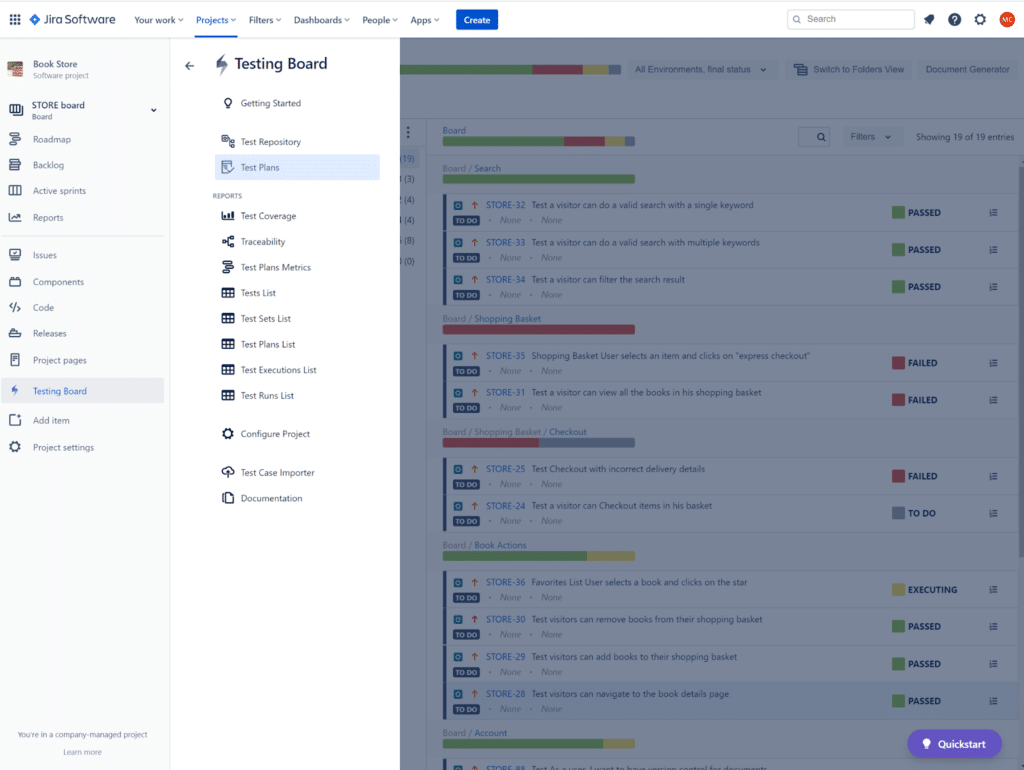
| Atlassian Marketplace rating | 3.5/4 (399 reviews across hosting types) |
| Pricing | USD 10 for up to 10 users First 100 users USD 5 / monthly per user |
Xray is a complete solution for native test management. It helps teams plan, test, track, and release error-free software.
Key features:
- Manage manual and automated tests as Jira issues
- Customize screens, fields, and workflows
- Write tests in Cucumber
- Create test plans
- Visualize test coverage through charts
- Analyze the status of test entities
Best for using Jira native issue types to manage testing artifacts
Zephyr Squad – Test Management for Jira

| Atlassian Marketplace rating | 3.2/4 (851 reviews across hosting types) |
| Pricing | USD 10 for up to 10 users First 100 users USD 5.11 / monthly per user |
Zephyr offers essential test management tools integrated within Jira. It helps ensure efficiency and collaboration throughout the testing lifecycle.
Key features:
- Plan and execute tests within a single Jira project
- Incorporate BDD in Jira workflows
- Access impactful, real-time metrics
- Synchronize automated test results (e.g. through SmartBear or popular open-source testing frameworks)
Requirements & Test Management for Jira
| Atlassian Marketplace rating | 3.4/4 (44 reviews across hosting types) |
| Pricing | Free up to 10 users First 100 users USD 1.65 / monthly per user |
Requirements and Test Management for Jira (RTM) is a functional test management tool. It integrates the entire software project within Jira. It encompasses requirements, development, and reporting.
- It lets link Requirements, Test Cases, and Defects directly to Jira issues. These capabilities culminate in comprehensive Test Plans covering all Test Cases.
- The Test Executions have the same structure as reusable Test Plans. This lets you monitor the statuses of particular actions. In the end, the Test Execution view displays all the defects that occurred during the process.
Key features:
- Tree folder structure and navigation modules
By default, an All folder summarizes all elements within the tree. Furthermore, you can categorize folders based on parameters. For example, you can categorize them by sprint, component, assignee, or any other criteria. It simplifies requirement-test case relationships and enables easy navigation.
- Traceability matrix
The Traceability Matrix shows all relations on a special panel. This makes verifying their statuses easier and more efficient. With this functionality, you can:- Make sure that Requirements are covered by related Test Cases
- Check if all Test Cases are included in Test Plans and Test Executions
- Track the defects linked to particular Test Cases and Test Execution
- Verify Test Executions linked to Test Plans
- Customize X and Y axes with JQL to set the filters to fit your needs
- Requirement Test Coverage Report
This report allows for verifying whether the requirements are covered by Test Cases, Test Plans, Test Executions, Test Case Executions, and Defects. It works for a given Project, Issue type, Fix version, Component, RTM Environment, and Assignee. You can decide which fields to present in the report by clicking on Preferences.
TestFLO – Test Management for Jira
| Atlassian Marketplace rating | 3.4/4 (46 reviews across hosting types) |
| Pricing | USD 825 / per year for up to 50 users USD 1 925 / per year for up to 50 users |
TestFLO is a fully customizable test management solution. It facilitates the complete test process in Jira. It offers tracking from start to finish. This app uses custom fields and workflows. It helps teams execute complex testing processes.
You can keep the test repository, test execution, and requirements in separate Jira projects. Or, you can combine them based on your team’s preferences.
Key features:
- Preconditions field with a reusable repository of preconditions
- Add comments, attachments, and defects in single steps when executing a Test Case
- Test Automation module
Trigger CI Server tests from Jira. When all tests are completed, gather and send results to Jira. TestFLO creates Test Cases in the Test Plan based on a given test result. Thanks to this, you don’t have to change the context between CI Server and Jira to run tests.
Reports
- Test Plan Iterations Report
Execute tests and analyze the overview of all Test Plan iterations. Use advanced workflow configurations provided by the app to force execution. If you need to perform another cycle of tests from the same Test Plan, you can create the next iteration based on the selected strategy. You can choose all Test Cases, only failed, ones not passed, or your custom selection.
- Test Plan Execution Report
The Test Plan Execution Report provides valuable insights. First, it will help you check the current state of the tests according to your need for granularity. Moreover, the report can be tailored based on Test Case status or Test Case steps progress.
- Requirements Traceability Report
Track the full relationship between requirements, tests, their execution, and reported defects. This report verifies the full picture of this part of the process. It is transparent and becomes much simpler.
Best practices for choosing Jira tool for testing
The right Jira test management tool can increase your team’s testing efficiency. It can also improve your software quality. However, with so many options available, it can be difficult to find the perfect solution. Here are some best practices for choosing a Jira test management tool. They can help you make an informed decision.
Consider your core requirements
Start by identifying the essential capabilities you need from a Jira test management tool. These may include test case management, test execution, test reports, automation, and collaboration. After that dive into more advanced features.
Check the integration with Jira
Ensure the tool integrates with your existing Jira instance. It should allow for data exchange and workflow synchronization. This will minimize the need for manual data entry and improve overall efficiency.
Look for key features
Check the availability of critical features. It can be customizable dashboards, comprehensive reporting, test automation integration, and collaborative tools.
Think about scalability
As your team and projects grow, your testing needs will evolve. Choose a tool that can handle the increasing number of users and project volumes.
Prioritize security
Data security is important, especially when handling sensitive information. Evaluate the tool’s data encryption. Evaluate its user access control. Evaluate its compliance with security standards. Check if it offers detailed logs.
Ensure usability
Choose tools with a user-friendly interface. This will make navigation to manage test cases, execute tests, and analyze results efficiently. Look for tools that offer templates and pre-built frameworks. These will streamline the testing process.
Check pricing models
Compare pricing models, including per-user fees, flat monthly rates, and free options. Choose a model that aligns with your team’s size, budget, and usage needs.
Read reviews
Gather insights from reviews, user feedback, and industry experts. This will help you understand each tool’s strengths, weaknesses, and overall user experience.
Comparison of Jira and dedicated test management tools
| Criteria | Standalone Jira | Jira with test management add-on |
| Test case management | Limited native capabilities for basic test case execution. | Enhanced and specialized features for in-depth test case management. |
| Workflow efficiency | General project management workflows. | Tailored workflows specifically designed for test planning and execution. |
| Traceability and reporting | Limited/no traceability features and reporting options. | Comprehensive traceability and advanced reporting capabilities. |
| Test automation support | No direct support for test automation. | Robust support for both manual and automated testing processes. |
| Collaboration features | Collaboration features focused on project management and development. | Enhanced collaboration within testing teams, addressing testing needs. |
| Ease of use | User-friendly interface for general project management. | Customized interface designed for efficient test planning and execution. |
| Scalability for testing | May face challenges in handling complex testing processes. | Built to handle intricate testing requirements and scalable as per needs. |
| Security measures | General security measures for project data. | Security protocols may vary based on the add-on but often comply with standards. |
| Cost considerations | Cost-effective for basic project management needs. | Additional costs for the add-on, vary based on features and subscription plans. |
Summary
Although Jira isn’t a dedicated test management tool, you can customize it with apps. Jira’s core purpose is managing workflows and data. This makes it an excellent foundation for streamlined testing processes. Using a single platform to track development, requirements, and tests is undoubtedly beneficial for your team. It is also economically wise.
FAQs about test management in Jira
-
What is Jira?
Jira is a popular project management and issue-tracking tool developed by Atlassian. Software development teams widely use it to manage and track tasks, issues, and workflows throughout the software development lifecycle.
-
Can Jira be used for testing?
Yes, Jira can be used for testing. It is a popular issue-tracking tool that can be used to manage test cases, track test progress, and generate reports. Jira is a good choice for teams that are already using Jira for project management and development.
-
Is Jira a performance testing tool?
No, Jira is not a performance-testing tool. It is a versatile project management and issue-tracking tool. Teams often use dedicated performance testing tools in conjunction with Jira for comprehensive testing.
-
Is Jira a good test management tool?
Jira can serve as a basic test management tool, offering features for test case management. However, for more advanced test management capabilities, teams often opt for dedicated test management add-ons available in the Atlassian Marketplace.
-
What is the Return on Investment (ROI) for using test management tools for Jira?
Using test management tools for Jira can result in several cost savings, including:
Reduced bug fixing costs: Bugs that are detected early in the development process are typically less expensive to fix than bugs that are detected later.
Reduced development time: Automation can free up your testers to focus on more complex testing activities, which can lead to a faster development process.
Reduced rework: Better communication can help prevent bugs from being introduced into the codebase in the first place, which can save you time and money in the long run.
-
How do test management tools for Jira facilitate parallel testing?
Test management tools for Jira can facilitate parallel testing by allowing you to create multiple test plans, assign tests to different testers, and track the progress of tests in real time.
-
What are test management tools for Jira?
Test management tools for Jira are add-ons or applications that can be used to extend the testing capabilities of Jira. These tools can provide many features that can help you to improve your testing process. It can be test case management, test execution, reporting, or integrations.
-
Do these tools offer any AI or machine learning features for predictive analytics in testing?
Yes, some test management tools.
-
What are the disadvantages of testing with Jira?
While Jira offers versatility, its native capabilities for test management may be limited for complex testing needs. Disadvantages include challenges in organizing and planning tests. It’s difficult to reuse test cases. There’s no built-in support for test automation. And reporting on test coverage or traceability is limited. Teams often choose Jira-integrated test management solutions from the Atlassian Marketplace for comprehensive testing.




